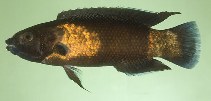| Family: |
Labridae (Wrasses) |
| Max. size: |
11.7 cm SL (male/unsexed) |
| Environment: |
reef-associated; marine; depth range 5 - 30 m |
| Distribution: |
Indo-West Pacific: Western Australia (Scott Reef) to Papua New Guinea; north to Japan. |
| Diagnosis: |
Dorsal spines (total): 9-9; Dorsal soft rays (total): 11-11; Anal spines: 3-3; Anal soft rays: 10-10; Vertebrae: 25-25. Body of male orangish in life; large females similar in body color with males except for the absence of the large orange area beneath and around the pectoral fin base and the black spot on the dorsal fin. Inconspicuous stripes on head of females; juveniles and small females with 3 broad black stripes on head and body, separated by narrow pale blue stripes. Posterior caudal peduncle and fin principally dark brown or black. Juveniles nearly identical to juveniles of Diproctacanthus but have a longer dorsal fin (Ref. 48636). |
| Biology: |
Occurs solitary or in small groups (Ref. 90102) in rich coral reefs in clear coastal to outer reef habitats. Adults feed on coral polyps but may also clean (Ref. 48636). Minimum depth range from Ref. 27115. |
| IUCN Red List Status: |
Least Concern (LC); Date assessed: 25 March 2009 Ref. (130435)
|
| Threat to humans: |
harmless |
Source and more info: www.fishbase.org. For personal, classroom, and other internal use only. Not for publication.

